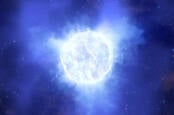This article is more than 1 year old
Don't beat yourself up for overeating in lockdown. This black hole scoffs equivalent of our Sun every day
No wonder J2157 clocks in at 34 billion solar masses
The greediest supermassive black hole spotted by us Earthlings is an eye-popping 34 billion times more massive than our Sun, and gobbles nearly a solar mass of nearby gas and dust every day.
The behemoth goes by the name SMSS J2157–3602 or J2157, for short, and was discovered in 2018 by eggheads led by the Australian National University (ANU). Now they have calculated the black hole’s properties in fine detail using near-infrared measurements taken by a mixture of ground-based telescopes and spacecraft. The details were published in a paper in the Monthly Notices of the Royal Astronomical Society this week.
“We knew we were onto a very massive black hole when we realised its fast growth rate,” said Fuyan Bian, co-author of the study and an astronomer working at the European Southern Observatory.
“How much black holes can swallow depends on how much mass they already have. So, for this one to be devouring matter at such a high rate, we thought it could become a new record holder. And now we know.”

Boffins baffled as supergiant star just vanishes – either it partially blew itself apart or quietly turned into a black hole
READ MOREThe team reckons it's the fastest growing black hole yet found, judging by its luminosity. J2157 is quasar, a type of black hole that devours matter pressed into an accretion disk around its event horizon. As gas and dust falls into the gaping void, the disk radiates electromagnetic energy. The more mass the quasar gobbles, the more luminous it appears.
“The black hole’s mass is also about 8,000 times bigger than the black hole in the centre of the Milky Way,” said Christopher Onken, lead author of the paper and a research fellow at ANU. “If the Milky Way’s black hole wanted to grow that fat, it would have to swallow two thirds of all the stars in our galaxy.”
J2157 is a particularly massive, ancient quasar that formed when the universe was just 1.2 billion years old, about nine per cent of its current age. The boffins hope that by studying specimens like J2157, they'll crack the longstanding mystery of how black holes grew to such gargantuan sizes during the early stages of the universe. Although the black hole is one of the most active quasars, it's not the most massive. There are a few that are roughly 40 billion solar masses, and one codenamed TON618 is even estimated to be 66 billion solar masses.
“Is this galaxy one of the behemoths of the early Universe, or did the black hole just swallow up an extraordinary amount of its surroundings? We’ll have to keep digging to figure that out,” Onken concluded. ®
